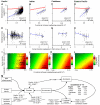Global human footprint on the linkage between biodiversity and ecosystem functioning in reef fishes
- PMID: 21483714
- PMCID: PMC3071368
- DOI: 10.1371/journal.pbio.1000606
Global human footprint on the linkage between biodiversity and ecosystem functioning in reef fishes
Abstract
Difficulties in scaling up theoretical and experimental results have raised controversy over the consequences of biodiversity loss for the functioning of natural ecosystems. Using a global survey of reef fish assemblages, we show that in contrast to previous theoretical and experimental studies, ecosystem functioning (as measured by standing biomass) scales in a non-saturating manner with biodiversity (as measured by species and functional richness) in this ecosystem. Our field study also shows a significant and negative interaction between human population density and biodiversity on ecosystem functioning (i.e., for the same human density there were larger reductions in standing biomass at more diverse reefs). Human effects were found to be related to fishing, coastal development, and land use stressors, and currently affect over 75% of the world's coral reefs. Our results indicate that the consequences of biodiversity loss in coral reefs have been considerably underestimated based on existing knowledge and that reef fish assemblages, particularly the most diverse, are greatly vulnerable to the expansion and intensity of anthropogenic stressors in coastal areas.
Conflict of interest statement
The authors have declared that no competing interests exist.
Figures




References
-
- Diraiappah A. K, Naeem S. Millennium ecosystem assessment: ecosystems and human well-being: biodiversity synthesis. Washington (D.C.): World Resources Institute; 2005.
-
- Butchart S. H. M, Walpole M, Collen B, van Strien A, Scharlemann J. P. W, et al. Global biodiversity: indicators of recent declines. Science. 2010;328:1164–1168. - PubMed
-
- Chapin F. S, Zavaleta E. S, Eviner V. T, Naylor R. L, Vitousek P. M, et al. Consequences of changing biodiversity. Nature. 2000;405:234–424. - PubMed
-
- Loreau M, Naeem S, Inchausti P, Bengtsson J, Grime J. P, et al. Biodiversity and ecosystem functioning: current knowledge and future challenges. Science. 2001;294:804–808. - PubMed
-
- Cardinale B. J, Srivastava D. S, Duffy J. E, Wright J. P, Downing A. L, et al. Effects of biodiversity on the functioning of trophic groups and ecosystems. Nature. 2006;443:989–992. - PubMed
Publication types
MeSH terms
LinkOut - more resources
Full Text Sources
Other Literature Sources

